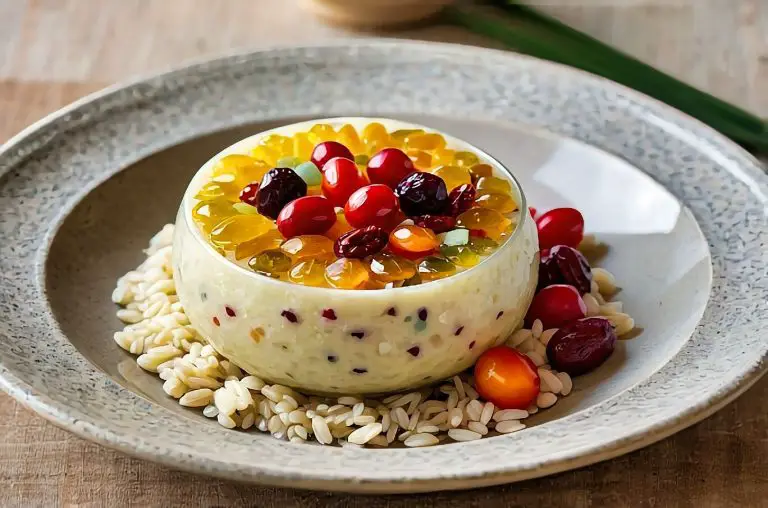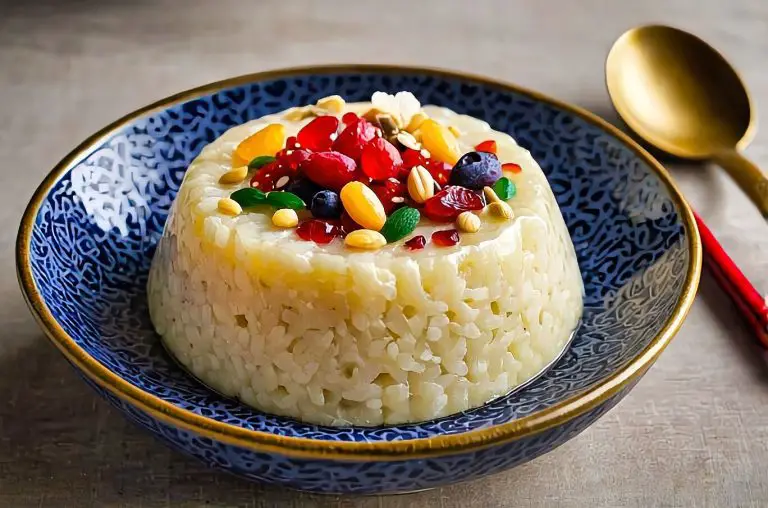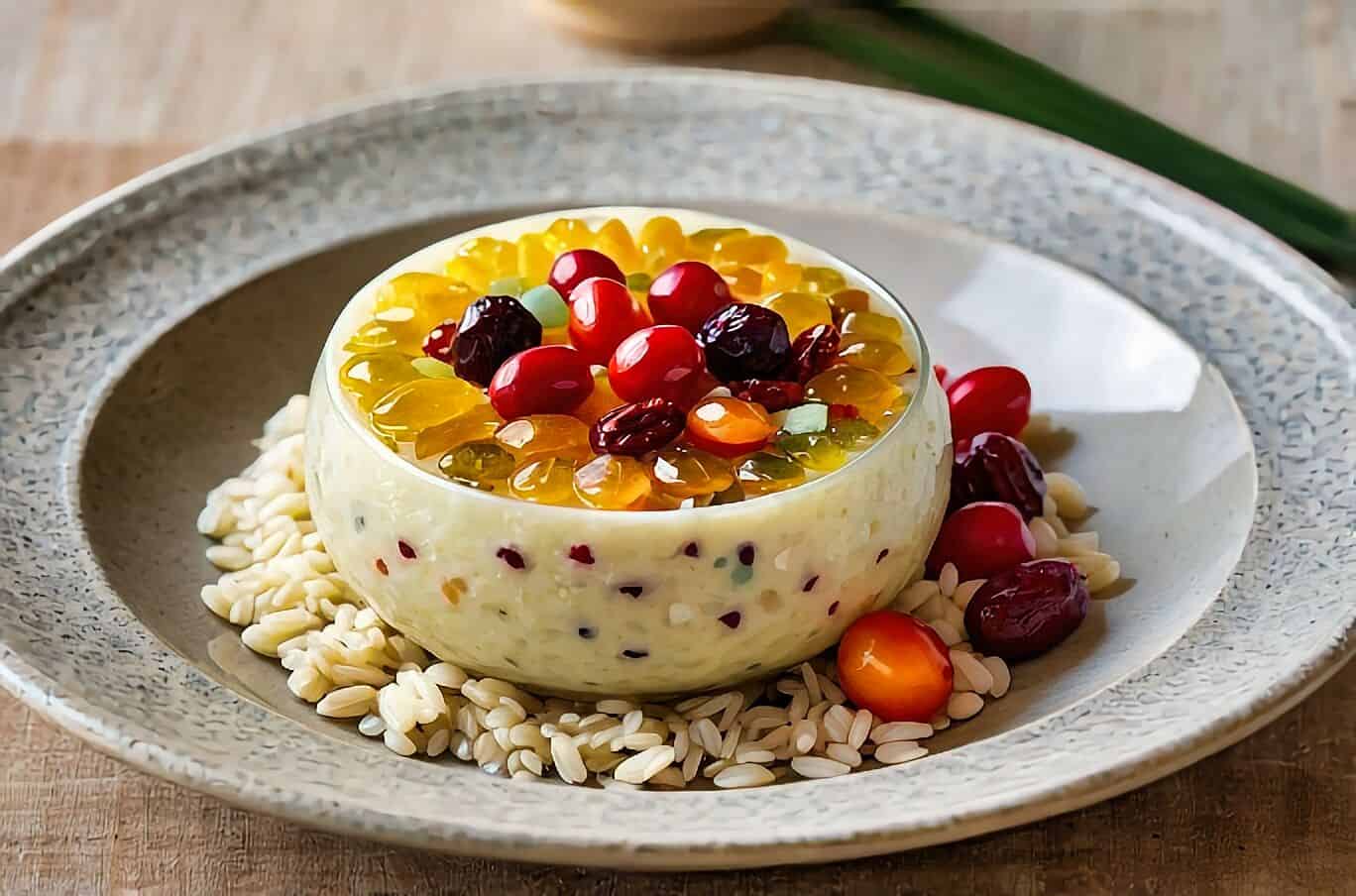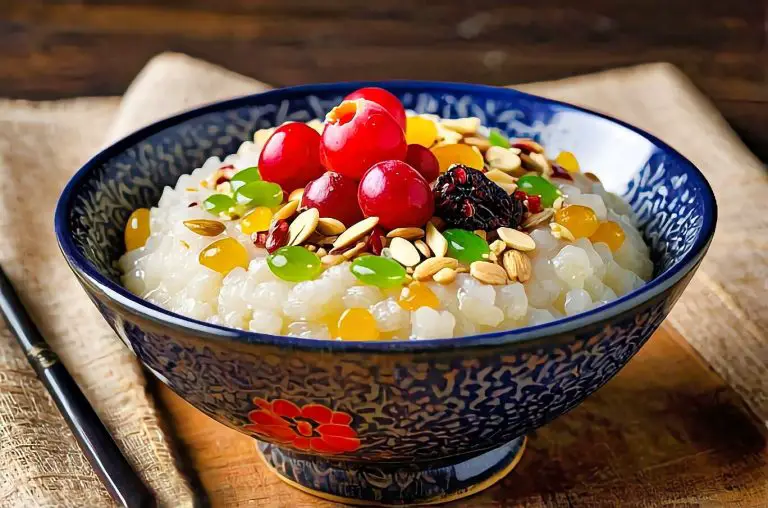Chinese 8 Treasure Rice Pudding recipe is a delightful dessert that combines sticky rice with various tasty toppings and fillings. This sweet dish is a staple during celebrations and is known for its unique texture and flavor, thanks in part to the red bean paste, dried fruits, and colorful ingredients that come together harmoniously. This flavorful combination makes the Chinese 8 Treasure Rice Pudding recipe an ideal choice for anyone looking to experiment with traditional Asian flavors while enjoying a sweet treat.
When crafting the Chinese 8 Treasure Rice Pudding recipe, I find it fascinating how each ingredient plays its part in creating a visually appealing and flavorful masterpiece. The glutinous rice serves as a perfect canvas for the vibrant toppings such as seeds and fruits, providing both texture and taste. The use of these ingredients ensures a dessert that not only satisfies the sweet tooth but also introduces the palate to diverse flavors and aromas.
What I love most about the Chinese 8 Treasure Rice Pudding recipe is its adaptability. The original recipe can be personalized with your choice of toppings and fillings, allowing for creativity in every dish prepared. While it remains simple in preparation, the result is a lush, comforting dessert that speaks volumes about the richness of its components. Whether you enjoy it during a festive gathering or as a special treat, this dish encapsulates the essence of sweet culinary exploration.
Recipe Composition
The Chinese 8 Treasure Rice Pudding recipe is a delightful dessert that integrates a variety of textures and flavors. The key element is glutinous rice, which provides a sticky and satisfying foundation for the dish. This texture plays well with the other components, creating a harmonious blend that is both chewy and rich.
I often incorporate red bean paste for its sweet and earthy taste. It complements the glutinous rice perfectly. This paste is usually nestled in the center, adding a surprise of flavor in every bite.
Sugar is another essential element, often used to accentuate the sweetness of the rice and the red bean paste. A balance is maintained to ensure that the dessert is not overwhelmingly sweet, but just right.
An assortment of nuts and seeds adds crunch and nutritional value. Ingredients such as almonds or melon seeds bring a distinct nuttiness that enhances the palate.
The inclusion of raisins and other dried fruits introduces a fruity and slightly tangy element. These add pops of flavor and bursts of natural sweetness throughout the dessert. Common choices include raisins, dates, and candied winter melon.
Overall, the Chinese 8 Treasure Rice Pudding recipe is a combination of various delightful ingredients that result in a unique and memorable dessert experience.

Preparation Techniques
To start with Chinese 8 Treasure Rice Pudding recipe, I like to focus on the perfect combination of steaming and mixing sticky rice with delightful ingredients.
The sticky rice serves as the base. It’s important to rinse it thoroughly. This step ensures that the rice is clean and gets rid of excess starch, which can make it too sticky and gummy.
After rinsing, I soak the rice for a few hours. This helps the rice cook evenly and become perfectly tender.
Steaming is the next critical step. I prefer using a steamer for this process. Once the rice is prepared, it needs to steam gently over simmering water for about 30 to 45 minutes. If you are pressed for time, a pressure cooker like an Instant Pot can speed things up.
For the filling, I often use a homemade red bean paste. Making the paste from scratch allows for better control of its sweetness and texture. It adds a rich and sweet layer to the pudding.
When it comes to toppings, I enjoy using a variety of dried fruits and seeds. They provide not only a visual appeal but also diverse textures and flavors that elevate the dish.
Don’t forget the syrup that ties everything together. A fragrant syrup can enhance the aroma and flavor profile of the pudding, adding a pleasing finish to each bite. The result is a Chinese 8 Treasure Rice Pudding recipe that bursts with flavor and texture, each component complementing the others harmoniously.
Significance of Ingredients
When I make Chinese 8 Treasure Rice Pudding, the choice of ingredients matters a lot. Each component contributes to the taste and texture, making this dish unique and flavorful.
Eight Treasure Rice often includes sticky rice, red bean paste, and dried fruits. Sticky rice is the base, giving the pudding its classic chewy texture. It’s an essential part of the dish.
Red bean paste adds a sweet element. This paste is smooth and rich, which complements the rice perfectly. The sweetness balances out the flavors from the other ingredients.
Dried fruits like plums or dates introduce natural sugars and a hint of tartness. They are not just for flavor but also add a pop of color to the pudding, making it visually appealing.
Nuts and seeds like lotus seeds provide a crunchy contrast. They are sometimes included for their health benefits, rich in vitamins and antioxidants.
For many, each ingredient symbolizes something greater. In Chinese cultures, especially during the Chinese New Year, certain ingredients are used to signify ideas like fortune, prosperity, and health. The choice and combination can vary, but the essence remains focused on balance.
These ingredients create a harmony in both flavor and symbolism. While the particulars of my recipe can differ, the heart of Chinese 8 Treasure Rice Pudding lies in the thoughtful combination of elements that achieve a delightful culinary experience.
Variations and Customizations
When it comes to the Chinese 8 Treasure Rice Pudding recipe, there are many ways to make it unique. One popular approach is to use an Instant Pot or pressure cooker. This method speeds up the cooking process and ensures a consistent texture.
For those needing a gluten-free option, it’s straightforward to adapt this dish. The main ingredient, sticky rice, is naturally gluten-free, and by carefully selecting other additions and toppings, we can easily accommodate dietary needs.
To customize the dish, I often play around with the types of dried fruits and nuts. Instead of the traditional dried fruits, I might use cranberries or apricots for a slightly different flavor. Nuts can vary too, like substituting almonds for peanuts, adding a crunchier texture.
I enjoy making the Chinese 8 Treasure Rice Pudding recipe part of my occasional culinary experimentation by incorporating different seeds, such as chia or flax, to enhance nutritional value. This not only adds a unique twist but also keeps the dish aligned with the essence of Chinese cuisine.
Experimenting with the syrup topping offers even more ways to personalize the recipe. A touch of coconut milk in the syrup provides a creamy richness, while infusing it with spices like cinnamon or cardamom can introduce an aromatic layer to the dessert.
By following these simple variations and customizations, I can make each serving of the Chinese 8 Treasure Rice Pudding recipe a little different each time.

Serving and Presentation
When serving Ba Bao Fan, a traditional touch is important in its presentation. I like to use a decorative platter to highlight the vibrant colors of the dish. The glossy appearance of the rice, accented with jewels-like ingredients such as jujube, goji berries, and golden raisins, makes it not just a treat for the taste buds but also a feast for the eyes.
I begin by ensuring that the rice has set well, which allows for a clean mold. After plating, I sprinkle longan and slices of apricot on top, adding contrast and a pop of color. The subtle osmanthus syrup gives a lovely sheen and an inviting aroma to the dessert. When using coconut oil, a light brushing adds shine without overpowering the delicate flavors.
The key to a polished look is uniformity. Each slice should reveal an enticing mosaic of fruits and textures. I find adding a small garnish of coconut flakes or perhaps a drizzle of extra syrup enhances both flavor and aesthetics.
Serving Ba Bao Fan as a centerpiece at a gathering always draws attention. This Chinese dessert, with its artful presentation, holds its own on any festive table. In my experience, such attention to detail elevates the dining experience, making each plate a memorable part of the meal. Guests often appreciate the thoughtful presentation as much as the unique taste.
Ingredients For the Chinese 8 Treasure Rice Pudding Recipe
For the Rice
Rice
White Sugar
For the Filling
Red Bean Paste
Topping
Dried Fruit

Cooking Instructions For the Chinese 8 Treasure Rice Pudding Recipe
Soak the rice
Glutinous rice should be rinsed under running water. Place it in a basin and pour water over it. Soak for the entire night. After thorough draining, combine with sugar.
Toppings
If required, peel and cut dried fruits. Soak in water overnight to soften any nuts, lotus seeds, peanuts, or jujubes (Chinese dates). You don’t need to soak other dried fruits and nuts before using them.
Assemble the bowl
To keep a bowl from sticking, evenly coat it with coconut oil (or butter or neutral cooking oil). Cover the bottom of the bowl with a layer of mixed nuts and dried fruit. Create a design if you want.
Place half of the rice on top of the nuts and dried fruit. Make a flat circle out of the red bean paste that is smaller than the bowl. Over the rice, place it. Add the remaining rice and use a spoon to flatten it.
Just enough water should be added to level the rice; take care not to push it about.
Pudding
The pudding bowl can be placed on a steamer rack or in a steamer basket. Pour water into the pot or wok. For fifty minutes, let it steam over medium heat. In case the wok or pot dries out, remember to check the water level halfway through.
After steaming, let it cool for about ten minutes. Next, lightly run a knife or spatula down the pudding’s edge to aid in separation. Over the bowl, place a serving dish. Turn over, then carefully take out the bowl.
You can enjoy the rice pudding warm or at room temperature. If you like a sweeter flavor, drizzle some honey over the dish before serving.
FAQ For the Chinese 8 Treasure Rice Pudding Recipe
Question: What is the Chinese 8 Treasure Rice Pudding recipe?
A: The Chinese 8 Treasure Rice Pudding recipe is a traditional dessert made with glutinous rice, mixed with eight different ingredients such as red beans, lotus seeds, dried fruits, and nuts. It’s often served during festive occasions for good luck.
Question: How do you make the Chinese 8 Treasure Rice Pudding recipe?
A: To make the Chinese 8 Treasure Rice Pudding recipe, you first steam glutinous rice and then layer it with the eight “treasures” such as sweet red beans, dried dates, lotus seeds, and other ingredients. The mixture is then steamed to create a fragrant, sticky dessert.
Question: What are the eight treasures in the Chinese 8 Treasure Rice Pudding recipe?
A: The eight treasures typically used in the Chinese 8 Treasure Rice Pudding recipe include red beans, lotus seeds, dried jujube dates, dried longan, walnuts, raisins, dried apricots, and almonds. These ingredients symbolize wealth, health, and happiness.
Question: Can I substitute any ingredients in the Chinese 8 Treasure Rice Pudding recipe?
A: Yes, you can substitute some of the ingredients in the Chinese 8 Treasure Rice Pudding recipe. For example, you can replace lotus seeds with chestnuts or swap raisins for other dried fruits like goji berries or cranberries.
Question: How should I store the Chinese 8 Treasure Rice Pudding?
A: The Chinese 8 Treasure Rice Pudding should be stored in an airtight container in the refrigerator for up to 2-3 days. You can steam it again before serving to reheat it and restore its soft, sticky texture.

8 Treasure Rice Pudding Recipe
Ingredients
- 1 cup Rice glutinous (aka sticky rice, sweet rice) - about 1 cup
- 1 tbsp White Sugar or brown sugar
- 3 tbsp Red Bean Paste homemade
- 1 handful mixed dried fruit and nuts.
Instructions
- Glutinous rice should be rinsed under running water. Place it in a basin and pour water over it. Soak for the entire night. After thorough draining, combine with sugar.
- If required, peel and cut dried fruits. Soak in water overnight to soften any nuts, lotus seeds, peanuts, or jujubes (Chinese dates). You don't need to soak other dried fruits and nuts before using them.
- To keep a bowl from sticking, evenly coat it with coconut oil (or butter or neutral cooking oil). Cover the bottom of the bowl with a layer of mixed nuts and dried fruit. Create a design if you want.
- Place half of the rice on top of the nuts and dried fruit. Make a flat circle out of the red bean paste that is smaller than the bowl. Over the rice, place it. Add the remaining rice and use a spoon to flatten it.
- Just enough water should be added to level the rice; take care not to push it about.
- The pudding bowl can be placed on a steamer rack or in a steamer basket. Pour water into the pot or wok. For fifty minutes, let it steam over medium heat. In case the wok or pot dries out, remember to check the water level halfway through.
- After steaming, let it cool for about ten minutes. Next, lightly run a knife or spatula down the pudding's edge to aid in separation. Over the bowl, place a serving dish. Turn over, then carefully take out the bowl.
- You can enjoy the rice pudding warm or at room temperature. If you like a sweeter flavor, drizzle some honey over the dish before serving.



1 comment
They named this correctly, It really is a treasure.